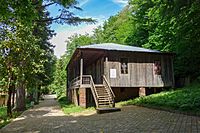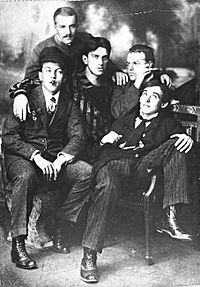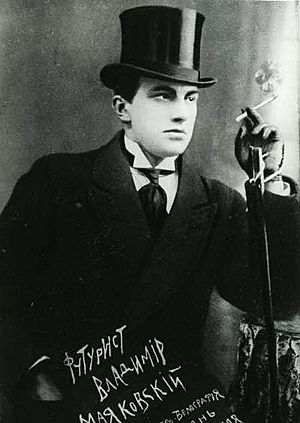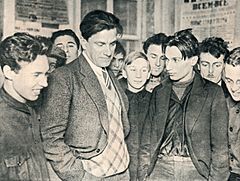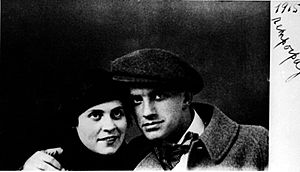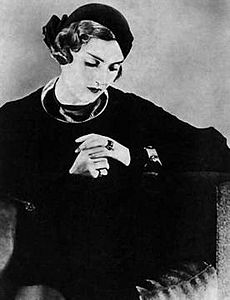Vladimir Mayakovsky facts for kids
Quick facts for kids
Vladimir Mayakovsky
|
|
|---|---|
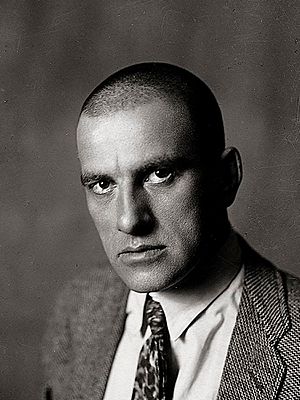
Mayakovsky in 1920
|
|
| Born | Vladimir Vladimirovich Mayakovsky 19 July [O.S. 7 July] 1893 Baghdati, Kutais Governorate, Russian Empire |
| Died | 14 April 1930 (aged 36) Moscow, Russian SFSR, Soviet Union |
| Citizenship | Russian Empire, Soviet Union |
| Alma mater | Stroganov Moscow State University of Arts and Industry, Moscow School of Painting, Sculpture and Architecture |
| Period | 1912–1930 |
| Literary movement | Russian Futurism |
| Signature | |
 |
|
Vladimir Vladimirovich Mayakovsky (UK: /ˌmaɪəˈkɒfski/, US: /ˌmɑːjəˈkɔːfski/; Russian: Влади́мир Влади́мирович Маяко́вский, IPA: [vlɐˈdʲimʲɪr vlɐˈdʲimʲɪrəvʲɪtɕ məɪˈkofskʲɪj]; 19 July [O.S. 7 July] 1893 – 14 April 1930) was a famous Russian and Soviet poet, playwright, artist, and actor. He was a key figure in the Russian Futurist movement. Futurism was an art style that focused on speed, technology, and the future.
Before the Russian Revolution in 1917, Mayakovsky became well-known as a leader of the Futurist movement. He helped write a famous Futurist statement called A Slap in the Face of Public Taste in 1913. He also wrote important poems like "A Cloud in Trousers" (1915).
Mayakovsky created many different kinds of works during his career. He wrote poems and plays, and even acted in films. He also edited an art magazine called LEF. During the Russian Civil War (1917–1922), he made posters to spread ideas for the Communist Party.
Even though Mayakovsky supported the ideas of the Bolsheviks and admired Vladimir Lenin, his relationship with the Soviet government was often difficult. He often disagreed with the government controlling art and telling artists what to create. Works that criticized the Soviet system, like his plays The Bedbug (1929) and The Bathhouse (1929), were not liked by the government.
Mayakovsky died in 1930. After his death, Joseph Stalin, the Soviet leader, called him "the best and the most talented poet of our Soviet epoch."
Contents
Vladimir Mayakovsky's Life and Art
Vladimir Vladimirovich Mayakovsky was born in 1893 in Baghdati, Georgia. At that time, Georgia was part of the Russian Empire. His father was a forester, and his mother was a homemaker. Vladimir had two sisters, Olga and Lyudmila.
His family spoke Russian at home. With his friends and at school, Mayakovsky spoke Georgian. He once said that three cultures were part of him: Russian, Ukrainian, and Georgian. He always thought of Georgia as a beautiful place.
In 1902, Mayakovsky started school. When he was 14, he joined in socialist protests in Kutaisi. His mother supported his activities. In 1906, his father died suddenly from an infection. After this, his mother moved the family to Moscow.
Early Education and Political Involvement
In Moscow, Mayakovsky became very interested in Marxism, a political and economic idea. He said that for him, nothing was better than the writings of Karl Marx. In 1907, he joined a secret group of Social Democrats at his school. He became a member of the Russian Social Democratic Labour Party that same year.
In 1908, he had to leave school because his mother could not pay the fees. For two years, he studied at the Stroganov School of Industrial Arts.
As a young activist, Mayakovsky handed out leaflets and was involved in helping political activists. This led to him being arrested several times. In 1909, he was imprisoned for 11 months. While alone in Butyrka prison, he started writing poetry. He later said that "Revolution and poetry got entangled in my head and became one." He was released in 1910.
After prison, Mayakovsky remained a socialist. However, he decided to focus on his education instead of political activities. He wanted to create "Socialist art."
Becoming a Futurist Poet
In 1911, Mayakovsky enrolled in the Moscow Art School. There, he met David Burlyuk, who became a close friend. Burlyuk heard Mayakovsky's poems and called him "a genius poet." Mayakovsky always gave credit to Burlyuk for helping him become a poet.
Mayakovsky became an important member of a group called Hylaea. This group wanted to break away from old art traditions. They would read poetry in public places and try to challenge the art world.
On November 17, 1912, Mayakovsky performed his poetry in public for the first time. In December, his first poems, "Night" and "Morning," were published. They appeared in the Futurist Manifesto A Slap in the Face of Public Taste. This manifesto was signed by Mayakovsky and other Futurists. It famously called for "throwing Pushkin, Dostoyevsky, Tolstoy, etc, etc, off the steamboat of the modernity." This meant they wanted to move past old literary styles.
In 1913, Mayakovsky's first poetry collection, I, was published. It had only 300 copies. In December 1913, Mayakovsky and other Futurists went on a tour across Russia. They visited 17 cities. Their performances were often wild, and sometimes the police had to stop the readings. Mayakovsky often wore a bright yellow shirt, which became his trademark.
The tour ended in April 1914. Mayakovsky and Burlyuk were expelled from the Art school because their public appearances were seen as too rebellious.
When World War I began, Mayakovsky tried to join the army but was rejected. He then worked for a company that made patriotic pictures and wrote anti-war poems. In 1915, he moved to Petrograd. He started writing for magazines, including one run by Maxim Gorky, a famous writer.
In June 1915, Mayakovsky met Lilya Brik. She became a very important person in his life and a source of inspiration for his work. Her husband, Osip Brik, also became Mayakovsky's close friend. This friendship and his views on the war influenced many of Mayakovsky's famous poems. These included A Cloud in Trousers (1915) and Backbone Flute (1915).
In 1916, a collection of his poetry called Simple As Mooing was published.
Art and the Revolution
Mayakovsky strongly supported the Bolshevik Russian Revolution. He even worked in Petrograd, where he saw Vladimir Lenin. He wrote in his autobiography, "To accept or not to accept, there was no such question… [That was] my Revolution." In November 1917, he joined an assembly of artists who supported the new government.
In 1918, Mayakovsky started a short-lived newspaper. He also acted in three silent films for which he wrote the scripts. Only one, The Lady and the Hooligan, still exists.
On November 7, 1918, Mayakovsky's play Mystery-Bouffe opened in Petrograd. This play showed a flood and the victory of the working class over the rich. A revised version in 1921 was very popular.
In March 1919, Mayakovsky moved back to Moscow. He started working for the Russian State Telegraph Agency (ROSTA). He created satirical posters with both pictures and text. These posters helped inform people about current events, especially those who could not read. His popularity grew quickly in the early Soviet Union.
His 1921 poem, 150 000 000, did not impress Lenin. However, Lenin liked his next poem, "Re Conferences."
Mayakovsky was a strong supporter of the Communist Party. He wrote many propaganda poems and educational booklets for children. He also gave lectures and poetry readings all over Russia.
In May 1922, he traveled abroad for the first time. He visited Riga, Berlin, and Paris. He met famous artists like Picasso. This trip led to new books of poems, including The West and Paris (1922–1925).
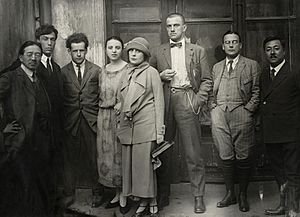
From 1922 to 1928, Mayakovsky was an important member of the Left Art Front (LEF). He helped create this group and its idea of "literature of fact, not fiction." He edited the magazine LEF. The magazine's goal was to rethink art and make it more useful for developing Communism. The first issue in March 1923 featured Mayakovsky's poem About That.
In October 1924, he gave many public readings of his long poem Vladimir Ilyich Lenin. He wrote this poem after the Soviet leader's death. Five years later, his reading of part of the poem received a 20-minute standing ovation. In May 1925, Mayakovsky traveled again. He visited several European cities, then the United States, Mexico, and Cuba. He later wrote a book of essays called My Discovery of America.
In January 1927, the first issue of the New LEF magazine came out, also led by Mayakovsky. In October 1927, he read his new poem All Right! to an audience in Moscow. In summer 1928, he became unhappy with LEF and left the group and its magazine.
Later Years and Challenges
In 1929, a collection of Mayakovsky's works was published in four volumes. However, his relationship with the Soviet literary world was getting worse. An exhibition celebrating 20 years of his writing in February 1930 was largely ignored by the RAPP and, more importantly, by the Party leadership. It was becoming clear that experimental art was no longer favored by the government.
Two of Mayakovsky's plays, The Bedbug (1929) and The Bathhouse (1930), were strongly criticized. In February 1930, Mayakovsky joined RAPP. But a leading member of RAPP criticized him in the newspaper Pravda. This criticism suggested Mayakovsky was linked to a political group that was out of favor. This was a serious accusation. Mayakovsky tried to fight back, but he was told to stop.
The negative campaign against him continued in the Soviet press. On April 9, 1930, Mayakovsky was shouted down by students during a reading of his new poem. They said his work was "too obscure."
Death
On April 12, 1930, Mayakovsky was seen in public for the last time. On April 14, 1930, he was found dead in his apartment. His funeral on April 17, 1930, was attended by about 150,000 people. It was one of the largest public mourning events in Soviet history. He was buried in the Moscow Novodevichy Cemetery.
Personal Connections
Mayakovsky met Lilya Brik and her husband Osip in July 1915. Lilya became his muse, inspiring many of his major poems. Osip Brik also became a close friend and helped publish Mayakovsky's books. The Briks' home became a meeting place for artists and writers. Mayakovsky dedicated many of his poems to Lilya.
In 1920, Mayakovsky had a brief relationship with artist Lilya Lavinskaya. She gave birth to a son, Gleb-Nikita Lavinsky (1921–1986), who later became a sculptor.
In 1925, Mayakovsky traveled to New York. There, he met Elli Jones, a Russian émigré. After he returned to the Soviet Union, Elli gave birth to their daughter, Patricia. Mayakovsky saw his daughter only once, in France, when she was three years old.
Patricia Thompson later became a professor and wrote a book about her parents' story. She visited Russia after the Soviet Union ended and started using her Russian name, Yelena Vladimirovna Mayakovskaya.
In 1928, in Paris, Mayakovsky met Tatyana Yakovleva, a young model. He fell deeply in love with her and wrote two poems dedicated to her. He tried to convince Tatyana to move to Russia, but she refused. In late 1929, he tried to get a visa to go to Paris to marry her, but he was denied. Many believed this was due to Lilya Brik's influence.
Mayakovsky's Legacy
After Mayakovsky's death, his works were initially stopped from being published. His name was also rarely mentioned in the Soviet press. However, in 1935, Lilya Brik wrote a letter to Joseph Stalin asking for his help.
This letter had a big impact. Mayakovsky was quickly declared a Soviet classic. He became the only artist from the early 20th-century avant-garde movement to become widely accepted in the Soviet Union. His birthplace in Georgia was renamed Mayakovsky in his honor. In 1937, the Mayakovsky Museum opened in Moscow. Triumphal Square in Moscow became Mayakovsky Square. In 1938, the Mayakovskaya Metro Station was opened.
For many years, Soviet readers knew Mayakovsky mainly as "the poet of the Revolution." His work was often changed, with some parts ignored and lines taken out of context to become slogans. The government turned him into a symbol of the state.
However, in the late 1950s and early 1960s, Mayakovsky's popularity grew again. A new generation of writers saw him as a symbol of artistic freedom and bold experimentation. Young poets gathered at Mayakovsky's statue in Moscow to read their poetry.
He influenced many Soviet authors, including Andrey Voznesensky and Yevgeny Yevtushenko. In 1967, the Taganka Theater staged a performance based on Mayakovsky's works.
Mayakovsky also became well-known and studied outside of the USSR. Poets like Nâzım Hikmet and Pablo Neruda said his work influenced them. He was very important for the Futurist movement in Lithuania. American poet Frank O'Hara was also influenced by Mayakovsky. In 1986, English singer Billy Bragg named his album Talking with the Taxman about Poetry after Mayakovsky's poem.
In the final years of the Soviet Union, some thought Mayakovsky's work was old-fashioned. But based on his best works, his reputation was revived. Mayakovsky is seen as a radical reformer of the Russian poetic language. He created his own unique style that influenced poetry around the world. Many in Russia see Mayakovsky as a revolutionary artist and a giant in 20th-century Russian literature.
There is a Mayakovsky monument in Kyrgyzstan, outside the capital Bishkek.
Literature
- Aizlewood, Robin. Verse form and meaning in the poetry of Vladimir Maiakovsky: Tragediia, Oblako v shtanakh, Fleita-pozvonochnik, Chelovek, Liubliu, Pro eto (Modern Humanities Research Association, London, 1989).
- Brown, E. J. Mayakovsky: a poet in the revolution (Princeton Univ. Press, 1973).
- Charters, Ann & Samuel. I love : the story of Vladimir Mayakovsky and Lili Brik (Farrar Straus Giroux, NY, 1979).
- Humesky, Assya. Majakovskiy and his neologisms (Rausen Publishers, NY, 1964).
- Jangfeldt, Bengt. Majakovsky and futurism 1917–1921 (Almqvist & Wiksell International, Stockholm, 1976).
- Lavrin, Janko. From Pushkin to Mayakovsky, a study in the evolution of a literature. (Sylvan Press, London, 1948).
- Mayakovsky, Vladimir (Patricia Blake ed., trans. Max Hayward and George Reavey). The bedbug and selected poetry. (Meridian Books, Cleveland, 1960).
- Mayakovsky, Vladimir. Mayakovsky: Plays. Trans. Guy Daniels. (Northwestern University Press, Evanston, Il, 1995). ISBN: 0-8101-1339-2.
- Mayakovsky, Vladimir. For the voice (The British Library, London, 2000).
- Mayakovsky, Vladimir (ed. Bengt Jangfeldt, trans. Julian Graffy). Love is the heart of everything : correspondence between Vladimir Mayakovsky and Lili Brik 1915–1930 (Polygon Books, Edinburgh, 1986).
- Mayakovsky, Vladimir (comp. and trans. Herbert Marshall). Mayakovsky and his poetry (Current Book House, Bombay, 1955).
- Mayakovsky, Vladimir. Selected works in three volumes (Raduga, Moscow, 1985).
- Mayakovsky, Vladimir. Selected poetry. (Foreign Languages, Moscow, 1975).
- Mayakovsky, Vladimir (ed. Bengt Jangfeldt and Nils Ake Nilsson). Vladimir Majakovsky: Memoirs and essays (Almqvist & Wiksell Int., Stockholm 1975).
- Novatorskoe iskusstvo Vladimira Maiakovskogo (trans. Alex Miller). Vladimir Mayakovsky: Innovator (Progress Publishers, Moscow, 1976).
- Noyes, George R. Masterpieces of the Russian drama (Dover Pub., NY, 1960).
- Nyka-Niliūnas, Alfonsas. Keturi vėjai ir keturvėjinikai (The Four Winds literary movement and its members), Aidai, 1949, No. 24.
- Rougle, Charles. Three Russians consider America : America in the works of Maksim Gorkij, Aleksandr Blok, and Vladimir Majakovsky (Almqvist & Wiksell International, Stockholm, 1976).
- Shklovskii, Viktor Borisovich. (ed. and trans. Lily Feiler). Mayakovsky and his circle (Dodd, Mead, NY, 1972).
- Stapanian, Juliette. Mayakovsky's cubo-futurist vision (Rice University Press, 1986).
- Terras, Victor. Vladimir Mayakovsky (Twayne, Boston, 1983).
- Vallejo, César (trans. Richard Schaaf) The Mayakovsky case (Curbstone Press, Willimantic, CT, 1982).
- Volk, Craig, "Mayakovsky Takes The Stage" (full-length stage drama), 2006 and "At The Top Of My Voice" (feature-length screenplay), 2002.
- Wachtel, Michael. The development of Russian verse : meter and its meanings (Cambridge University Press, 1998).
Images for kids
See also
 In Spanish: Vladímir Mayakovski para niños
In Spanish: Vladímir Mayakovski para niños


